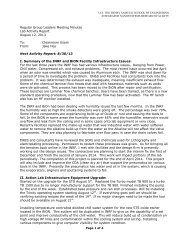Download Lab Safety Manual - Integrated Nanosystems Research ...
Download Lab Safety Manual - Integrated Nanosystems Research ...
Download Lab Safety Manual - Integrated Nanosystems Research ...
You also want an ePaper? Increase the reach of your titles
YUMPU automatically turns print PDFs into web optimized ePapers that Google loves.
lung tissue. Corrosives in the lab include acids and bases. In case of localized external exposure, promptly flush<br />
the affected area with plenty of water, for at least 15 minutes. For more general external exposure, use a safety<br />
shower. Remove clothing while under the shower and flush for at least 15 minutes. Exposure of corrosives to the<br />
eyes is extremely serious; flush immediately, either with a spray gun at your wet bench or the nearest eyewash<br />
station. Eyes should be rolled up and down, and side to side, continuously, to allow clean water to flush behind<br />
the eyeball. For any exposure to corrosives, you should get help. The victim should be taken to the emergency<br />
center for evaluation and treatment.<br />
• Oxidizer<br />
Technically, an oxidizer is a chemical compound that has a pair of electrons to donate to an electron-accepting,<br />
reducing agent. Very often, oxidizers are chemical compounds that contain a reactive oxygen component. When<br />
mixed with compounds that can act as reducing agents, the result is often a violent reaction, possibly an explosion.<br />
Oxidizers should not be stored or mixed with solvents, which generally make excellent reducing agents. At UCI,<br />
oxidizers are stored in the chemicals storage cabinet. The most commonly noted example in the lab of an oxidizer<br />
is hydrogen peroxide. However, other compounds, such as acetic acid and nitric acid, are oxidizers as well as<br />
corrosives.<br />
• Water Reactive<br />
Water reactive is used to describe compounds (generally concentrated acids and bases), which very quickly<br />
generate heat and/or gas upon mixing with water. The primary hazard presented by water-reactive mixtures<br />
should NEVER be poured directly into a sink drain. Aspirating water reactive mixtures is safe; the high dilution<br />
factor and rapid mixing dissipates heat and prevents superheating. Do not aspirate chemicals without first<br />
consulting with INRF staff and EH&S.<br />
• Flammable<br />
These compounds include most solvents, such as acetone, isopropanol, and methanol. In air, above a critical<br />
concentration, called the “flash point”, the vapors from a flammable can ignite and explode. The source of<br />
ignition may be heat (such as a hot plate) or a spark (such as from an electrical tool or static). Because the vapors<br />
can travel over considerable distances, the source of ignition can be far away from the flammables container itself.<br />
To minimize hazards, always work well within the exhausted area of the appropriate bench. The air pulled into<br />
the exhaust area will keep the concentration of vapors below the flash point. Where possible, minimize the<br />
quantities of flammables used. Before working with flammables, always note the location of the nearest safety<br />
shower and fire extinguisher. Flammables should be stored in the designated flammables cabinet; no flammables<br />
may be stored outside flammable cabinet.<br />
• Toxic/Poison<br />
A toxic material is one that has poisonous or harmful effects. There are formal, qualifiable definitions as to what<br />
comprises a toxic material and to what degree it is toxic. These definitions are based on lethal dosages for lab<br />
animals when administered orally or through inhalation.<br />
• Non-Toxic<br />
A non-toxic material is one that is not likely to result in harmful effects with NORMAL use. This designation is<br />
used sparingly. Pure water is considered non-toxic.<br />
11



